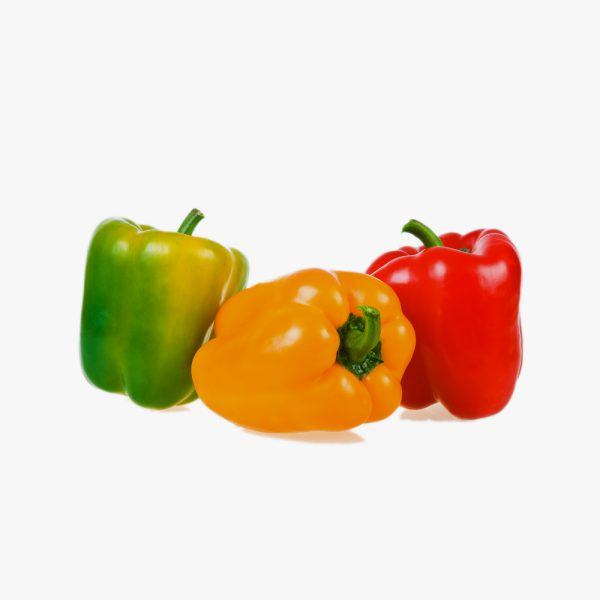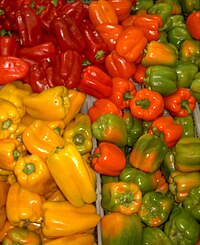
The misleading name “pepper” was mistakenly given to this plant by Christopher Columbus when he returned to Europe. At that time, any spice with a spicy taste was called pepper. The unique flavor of bell peppers makes them a key ingredient in many traditional and modern dishes. They are widely used to season chicken dishes, pasta, and salmon. Additionally, stuffed bell peppers are a popular traditional dish where the pepper is filled with various stuffing ingredients.
Medicinal Properties
This vegetable is rich in antioxidant compounds such as vitamin C and carotene. In 100 grams of raw red or green bell peppers and regular peppers, there are approximately 140 mg, 120 mg, and 120 mg of vitamin C, respectively, as well as 3,840 mcg, 265 mcg, and 175 mcg of beta-carotene.
Effect of Bell Peppers on Colds
Due to their high vitamin C content, bell peppers are beneficial in treating colds. Regular consumption of this vegetable in one’s diet helps reduce both the severity and duration of colds. A single bell pepper provides 300% of our daily vitamin C requirement and supplies a significant amount of vitamin A and beta-carotene. Bell peppers promote heart health, overall well-being, and have anti-aging properties.
Velora Fruits, utilizing the latest global technologies, is one of the largest producers and suppliers of premium Iranian bell peppers to international markets.

“Velora Fruits Export-Quality Lamp-Shaped Eggplants”

Eggplant: Origin, Characteristics, and Culinary Uses
Eggplant (also known as aubergine) is an edible plant from the Solanaceae (nightshade) family, which is actually a flowering plant. It is believed to have originated in India. This plant grows in all tropical and subtropical regions and can reach a height of 40 to 150 cm.
Eggplant is a delicate, perennial, and tropical plant that is often cultivated as a tender, semi-hardy annual in temperate regions. Its stem is often spiny. The eggplant flower is white to purple, with five petals and yellow stamens.
The plant grows between 40 and 150 cm tall. It has large, rough, and serrated leaves that measure 10 to 20 cm in length and 5 to 10 cm in width. Semi-wild varieties can grow up to 225 cm tall, with leaves over 30 cm long and 15 cm wide. In wild plants, eggplants are usually less than 3 cm in diameter, but in cultivated varieties, the fruit is much larger, reaching up to 30 cm or more. The fruit is oval, shiny, purple, with white flesh and a spongy texture. When cut, the exposed surface quickly turns brown.
Botanically classified as a berry, eggplant contains numerous small, soft seeds that, despite being edible, have a slightly bitter taste due to their nicotine-like alkaloid content, similar to tobacco.
It should be noted that the Isfahan Lamp-Shaped Eggplant is one of the finest varieties. Eggplant is cooked differently across various countries, depending on local taste and culinary traditions.
In Iran, different cities have unique ways of preparing dishes with lamp-shaped eggplant. In the northern regions, popular dishes like Mirza Ghasemi and Kashk-e Bademjan are prepared using distinct cooking methods, whereas in other cities, simpler techniques are used.
Regarding its appearance, eggplant comes in a variety of colors, including white, black, purple, red, and dark green. Its shape may be elongated or round.
The word “eggplant” is believed to have originated from Sanskrit, where it was called “Vatin Janah” or “Batin Janah”, meaning “wind-resistant.” Upon entering the Persian language, it evolved into “Badin Janah”, which later changed to “Bademjan” or “Badingan”.
Another interpretation of the name suggests that the eggplant stays fresh as long as it remains attached to its stem but wilts as soon as it is detached, which is why it was named “Bademjan” (meaning “having life as long as it has a stem”).

Velora Fruits Export-Quality Lamp-Shaped Eggplants
Velora Fruits, utilizing the latest global technologies, is one of the largest producers and suppliers of premium Iranian lamp-shaped eggplants to international markets.








